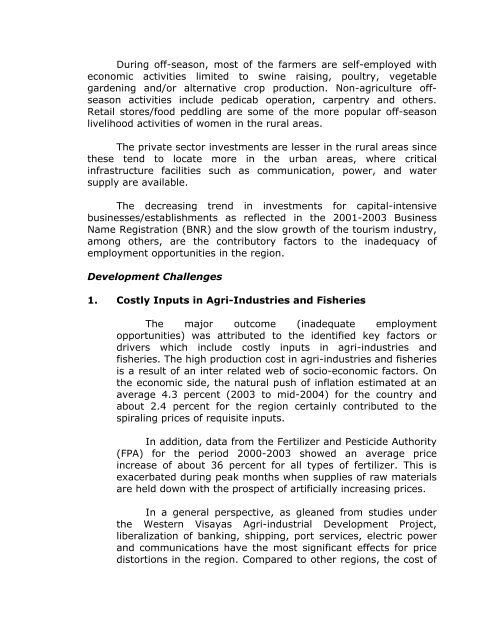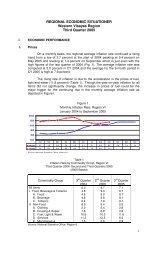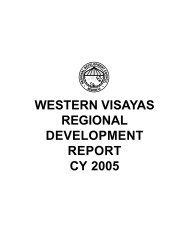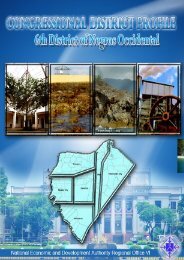Chapter III.pdf - NEDA-RDC VI
Chapter III.pdf - NEDA-RDC VI
Chapter III.pdf - NEDA-RDC VI
Create successful ePaper yourself
Turn your PDF publications into a flip-book with our unique Google optimized e-Paper software.
During off-season, most of the farmers are self-employed with<br />
economic activities limited to swine raising, poultry, vegetable<br />
gardening and/or alternative crop production. Non-agriculture offseason<br />
activities include pedicab operation, carpentry and others.<br />
Retail stores/food peddling are some of the more popular off-season<br />
livelihood activities of women in the rural areas.<br />
The private sector investments are lesser in the rural areas since<br />
these tend to locate more in the urban areas, where critical<br />
infrastructure facilities such as communication, power, and water<br />
supply are available.<br />
The decreasing trend in investments for capital-intensive<br />
businesses/establishments as reflected in the 2001-2003 Business<br />
Name Registration (BNR) and the slow growth of the tourism industry,<br />
among others, are the contributory factors to the inadequacy of<br />
employment opportunities in the region.<br />
Development Challenges<br />
1. Costly Inputs in Agri-Industries and Fisheries<br />
The major outcome (inadequate employment<br />
opportunities) was attributed to the identified key factors or<br />
drivers which include costly inputs in agri-industries and<br />
fisheries. The high production cost in agri-industries and fisheries<br />
is a result of an inter related web of socio-economic factors. On<br />
the economic side, the natural push of inflation estimated at an<br />
average 4.3 percent (2003 to mid-2004) for the country and<br />
about 2.4 percent for the region certainly contributed to the<br />
spiraling prices of requisite inputs.<br />
In addition, data from the Fertilizer and Pesticide Authority<br />
(FPA) for the period 2000-2003 showed an average price<br />
increase of about 36 percent for all types of fertilizer. This is<br />
exacerbated during peak months when supplies of raw materials<br />
are held down with the prospect of artificially increasing prices.<br />
In a general perspective, as gleaned from studies under<br />
the Western Visayas Agri-industrial Development Project,<br />
liberalization of banking, shipping, port services, electric power<br />
and communications have the most significant effects for price<br />
distortions in the region. Compared to other regions, the cost of








